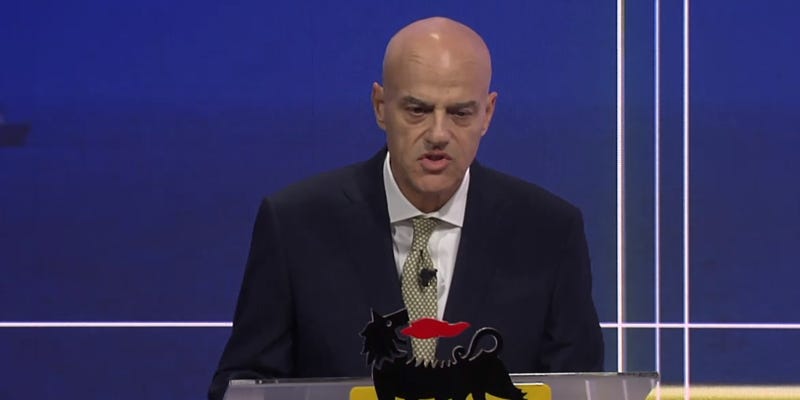Oil company Eni plans 8.1 million hectare land grab in Africa for carbon offset plantations
Italian oil and gas company Eni has announced plans to establish plantations over an area of 8.1 million hectares in Africa. The proposal is part of the company’s plans for greenhouse gas emissions from its exploration and production operations to be “net zero” by 2030.
Here’s how Eni’s chief executive Claudio Descalzi described his company’s plans at Eni’s annual strategy presentation on 15 March 2019:
“Today, we announce a new target, of our decarbonisation process, to achieve net zero emissions in our upstream business by 2030. We will do this by increasing efficiency to minimise direct upstream CO2 emissions and by 2025, we will eliminate gas processed flairing and reduce methane emisions by 80%, and offsetting residual upstream emissions through large forestry projects.”
Eni’s “upstream” business refers to the dirty job of digging fossil fuels out of the ground and processing them. Digging out fossil fuels and burning them is what’s driving climate breakdown. Conversely, leaving fossil fuels in the ground is the only way of addressing climate change.
Burning the fossil fuels the Eni extracts has a far greater impact on the climate than the emissions from digging them out, but so far Eni isn’t even pretending to address those emissions.
The fact that Eni has no plans to stop drilling was clear from Descalzi’s presentation:
Eni and REDD
In 2017, Eni published a “Decarbonization” report. In the same year, the company started buying carbon credits “to compensate part of its own direct emissions”. Eni bought 680,000 forestry credits, which offset 1.6% of the company’s own emissions.
The “Decarbonization” report explains that,
The credits purchased were generated by projects in the Democratic Republic of Congo, Indonesia, Mexico and Ghana. At the same time, development for two REDD (Reducing Emissions from Deforestation and forest Degradation) was started in Ecuador and Ghana.
Descalzi had more to say about his company’s proposed new plantation projects:
Buying carbon credits is no longer enough. We will use our scale in our geographical positions to take an active participation in forestry initiatives, that will bring wider community benefits, such as new jobs, and economic empowerment for local communities. This will become a structural component of our decarbonisation business model. We have already created the first partnership for REDD+ project development, our final target is to reach a potential more than 20 million ton per year of CO2 sequestration by 2030.
Descalzi did not mention what species will be planted. The Financial Times reported that Eni will “plant a forest” covering 8.1 million hectares, but the reality is that Eni’s massive tree planting scheme will result in industrial tree plantations, not a forest.
Descalzi mentions the jobs that his company’s offsetting plans will create. But this is one of the lies that the plantation industry promotes.
REDD-Monitor recommends that Descalzi should read “Ten Replies to Ten Lies”, written by Ricardo Carrere of the World Rainforest Movement in 1999. In that short report, Carrere demolished the lies of plantation industry:
Large-scale plantations generate employment mainly during planting and harvesting. After the trees have been planted, employment opportunities fall dramatically. When the trees are ready to be harvested, workers are hired once again but, increasingly, these jobs are tending to disappear because of the growing mechanization of this operation.
Descalzi’s discomfort?
Descalzi faced a question about reforestation versus carbon capture and storage (CCS). I’m not a poker player, but Descalzi’s body language is revealing while he answers this question. Desclazi covers his mouth and coughs. He hesitates. He clenches his fists – which could mean either firmness of resolve, or discomfort.
Descalzi replied to the question as follows:
You ask, the natural sink sequestration versus the CCS. Clearly the natural sink is the less expensive, much less expensive. And we range in about between 11 and 15 on average, because that is the cost of the recovery of investment, investment not so much, 11 dollars per ton. So is, er, is, er, less heavy and less expensive than the CCTS [Carbon Capture Transport and Storage]. Clearly we are working also on this issue in different way.
Clearly, forestry for us is more than aquire created, because you can buy, it’s a bit more expensive, or less expensive, it depends, but it really is impacting our communities. We are doing, and we are going to do in Africa, in the country where we operate, but generally speaking in Africa, because we do also in other countries like Zimbabwe, like South Africa, we are not really in operation, we are in Mozambique, in Ghana.
So we have projects that are impacting the society, is really creating a lot of jobs. Is creating a different kind of diversification, with agriculture, but also this is a diversification.
The model is quite strange because we are working with developers, we are not yet a developer. We started as a developer in small areas, well big area, but small compared to what we are using now in Ghana, so we want to work there because we have a lot of communities, but it is also we are engaged, there is commitment to buy the credits, and then we give back to the community some percentage that can go from 10 to 40%, relating to the gain that you make from credit you buy.
So it’s really, it’s good for the environment, it’s really good for the communities, and clearly for us it is good because it is a way to offset, offset our residual upstream emissions.
So this is what Natural Climate Solutions are going to look like. Millions upon millions of hectares of monoculture industrial tree plantations, planted on land belonging to some of the poorest people in the world.







